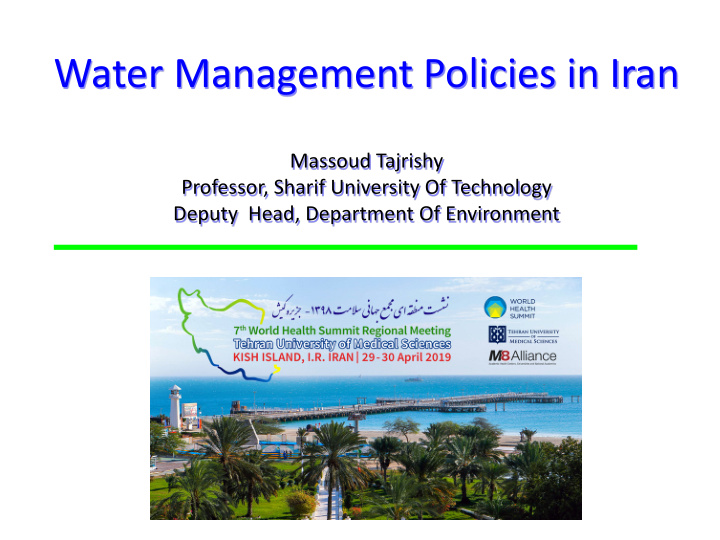



Water Management Policies in Iran Massoud Tajrishy Professor, Sharif University Of Technology Deputy Head, Department Of Environment
Water M Management P Policies i in Iran Outline 1. Overview of Water Resources and Demand 2. Major challenges 3. Recent Approaches and Water Policies 4. Conclusions
Ove vervi view of of Water R Resou ources and Demand
Six major water basins and rate of precipitation in Iran Area Rainfall As % of Basin (×10ˆ3 (km3/ total Km2) year) rainfall 831 Central Plateau 138 32 Persian Gulf 430 162 38 and Oman sea 177 Caspian Sea 83 19.5 106 Hamoun Lake 12 3 53 Orumie Lake 19 5 44 Serakhs 11 2.5 Major catchment Basins location Total 1641 425 100
Water availability and use in Iran
Renewable fresh water supply per person annually 1988-2020
Yield, area and production for irrigated and rainfed wheat during 1983-2003
Major C or Cha hallenges a and nd Trends ds
Major Chal allen enges es and Tren ends 1. Unbalance use and supply of water resources 2. Excessive withdrawal of groundwater resources 3. Demand Management in accordance to priorities set in the National Water Plan 4. Pollution of water resources and its economic and environmental consequences 5. Efficiency in water irrigation systems 6. Risk Management of water related natural disaster ( i. e. drought and flood) 7. Implementation of National Integrated Water Resources Management 8. Efficient and equitable water price for various uses 9. Land use planning 10. Unaccounted for water (UFW)
11
12
Sink holes – Ground Water Extraction (Semnan)
Hamedan Sink Hole Hamedan Power plant
Moh oharlu lu (2000 000-2018 2018) Lake surface area (km2) 16
Sand dune movements in west and east of the lake Urmia Shabastar 17
Lake Urmia (2000-2017) Lake surface area (km2) 18
1393/4/25ﻞﺑاز Esfahan, July 13 th 2017 Khoramabad, June 19 th 2016 Bandar-e-Abbas, Nov. 22, 2016 Tehran, May 23 rd 2014 Mashad, July 1 st 2016 Zabol, July 5 th 2016 Urmia lake Zanjan 19
Impacts of Socio-Economic • The most important Impacts: - Schools and Offices Closure and Cancelation of Flights - Immigration - Pulmonary, Respiratory, Cardiovascular and Mental Diseases - Reduction of visibility - decrease in production of food industries, crops (such as date) and livestock - Reduce number of bees and honey production Date production also dropped by more than 60 percent in 2010
Table: Amount of Economical Damages by SDS in Agriculture and Natural Resources Sectors Total Sum Kind of Damages Description of Damage Costs (Million Rials) (Billion) Reduce the amount of aquaculture production due to reduced sunlight 182500 Reduce production of imagination Reduce Biological Productivity Drop production of wheat and rain products 186937 7471 Reduce fruit production in gardens (citrus, pomegranate, figs, 2833000 grapes, dates, others) Reduce snacks production 4269000 Reforestation of the planting hands 1200000 Natural Reforestation 7718000 Restoration of pastures 621000 Pumping water of breeding fish for irrigation of plants for 60000 control of dusts Cost of reclamation and Guiding excess water of Drainage channel to wetlands 20000 9675 replacement Damage to computer systems 150 Damage to air conditioning systems 300 Damage to the engine and navigation systems of the floating 6000 vessels Damage to electricity network of fish farms and shrimp (fuses 50000 and fittings) The closure of government agencies and banks 10000 The closure Deceleration of services to aquatic animals due to frequent 50000 61 breaks 1000 Payment of damages and compensation to fishing activities 150000 150 during the occurrence of dust Immigration Exit of Investors in the Field of Aquaculture 100000 100 Health Increased allergic and respiratory illness for workers 20000 20 Total - 17477887 17478
Despite having a more advanced water management system than most Middle Eastern countries, similar to the other countries in the region, Iran is experiencing a serious water crisis. The government blames the current crisis on the changing climate, frequent droughts, and believing that water shortages are periodic. Dramatic water security issues of Iran are: rooted in decades of disintegrated planning and managerial myopia. A symptom-based management paradigm, which mainly focuses on curing the problem symptoms rather than addressing the main causes. Three major causes for the current water crisis: (1) Rapid population growth and inappropriate spatial population distribution; 23 (2) Inefficient agriculture sector; and
Annual Absolute Temperature Changes in 2035 in Comparison to 1961-1990 for Average Scenario Source: Iran’s Third National Communication on Climate Change
Range of Long-term Annual Average Precipitation in 2016-2030 in Comparison with 1982-2009 Source: Iran’s Third National Communication on Climate Change
Recent Approac aches a es and W Water er Policies es
Elements of Water Management • Policy Makers – Parliament – Supreme Water Council, presided by the President of Iran • Governance (Ministry of Energy) – Deputy Minister for Water Affairs (Iran Water Resources Management Company) – Regional Water Companies – Deputy Minister for Water & Wastewater Affairs (Water & Wastewater Engineering Company) – Provincial Water & Wastewater companies • Other Stakeholders – Ministry of Jihad-e-Agriculture – Ministry of Industry and Mines, – Ministry of Urban Development – Environmental Protection Organization
Recent Approaches and Water Policies • Promotion of private investment in water projects • Long-term development strategies for Iran’s water resources • Creation of water related councils • Promotion of sustainable development and environmental views in water resources management • Water management based on river basins • economic instruments: getting the prices right - to promote prudent use of water • monitoring programmes for surface and groundwaters, both as a planning tool and as an assessment instrument
How to Reach ? The long-term development strategies are on the basis of IWRM deserve to respond: • Economic efficiency • Water for food and social security • Water for environment and sustainable development
Recommend
More recommend